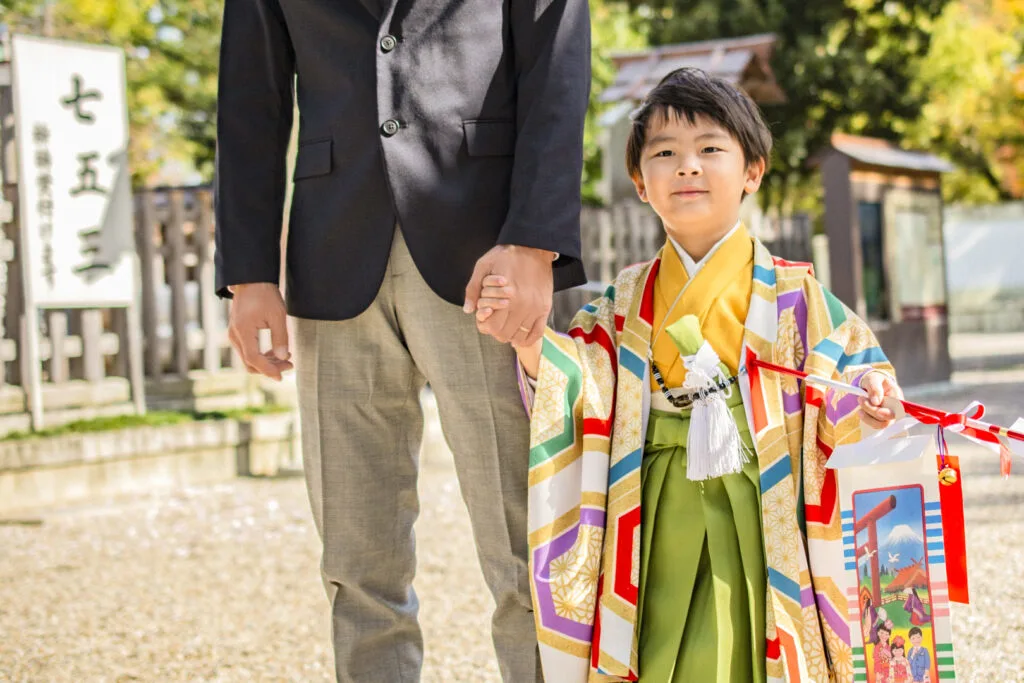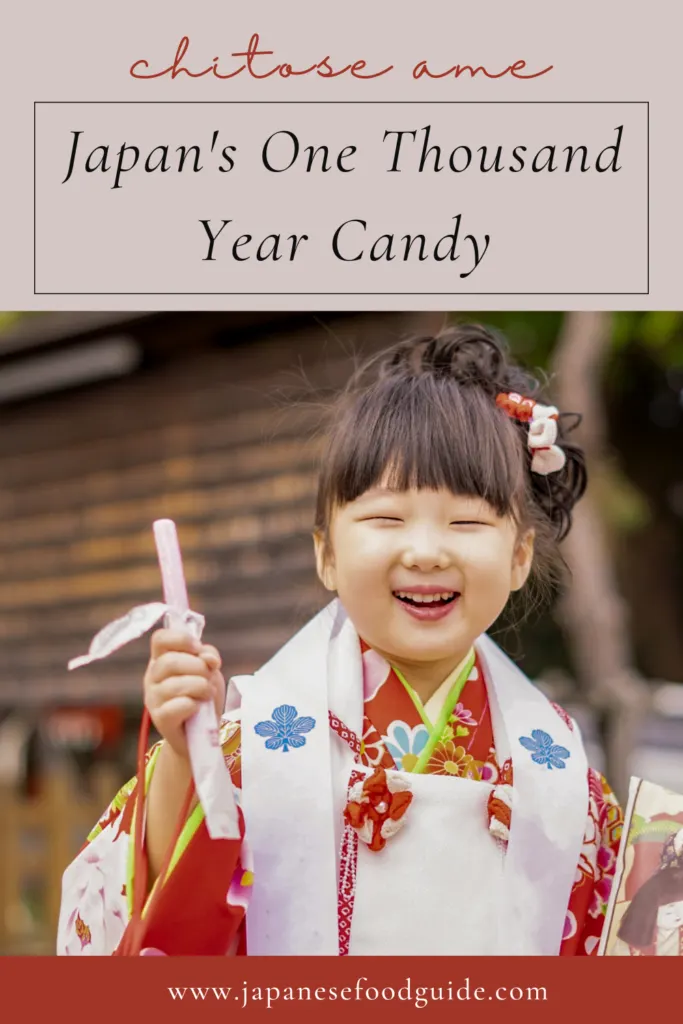Shichi Go San (七五三), a Japanese festival held annually in November, literally means ‘seven, five, three’ and celebrates the health and longevity of girls aged 3 and 7, and boys aged 3 and 5.
On Shichi Go San, children make their “debut” at the local shrine wearing traditional Japanese clothes and participate in a Shinto ritual to pray for a long and happy life, marking their passage into middle childhood. Afterwards, the family celebrate with a meal together and the children happily savor the traditional sweet of the festival, Chitose ame.
In this article, we’ll delve into what Chitose ame is and what it represents, other Shichi Go San food, as well as the significance of the festival as a whole.

Table of Contents
Firstly, why celebrate children at the ages of 3, 5 and 7?
The custom dates back to the Heian period (794-1185) when child and infant mortality was high. It began amongst court nobles and then spread to the samurai class who added several rituals. By the Meiji period (1868-1912), Shichi Go San had evolved to become part of mainstream culture.
The reason for celebrations to take place at the ages of 3, 5 and 7 were both practical and cultural. If a child reached the age of three or four, it was hoped they had passed the stage of imminent danger and would survive into adulthood. Some families would wait until this time to add children to the family register for this reason.
In addition, odd numbers are considered auspicious in Japanese numerology, and at the ages of three, five and seven, children were considered to have reached special cultural milestones, which we’ll explain below.
Today it continues as an important rite of passage observed by the whole family and is an occasion to get dressed up, visit a shrine, and have formal photographs and a meal together. You’ll find many photo studios and salons offering packages that include clothing rental, photography, and hair and make-up for the children as well as the entire family.
3 years old (girls and boys)
During the samurai era, it was customary for children to have their heads shaved at birth and was kept short until the age of three. The Shichi Go San festival marked the time when children could start growing their hair, referred to as kamioki (髪置き), meaning to “leave the hair”.
Although this custom is no longer observed, the age of three remains an important milestone in Japanese culture. Traditionally, both boys and girls have their first celebration at the age of three, however, nowadays it is more common for boys to wait until they turn five.
Therefore, girls celebrate Shichi Go San twice, at ages three and seven, and boys usually only once at the age of five.
At three years old, girls traditionally wear a kimono with a type of padded vest called a hifu.

5 years old (boys)
Boys celebrate Shichi Go San at five years old because when traditional clothing was the daily norm in Japan, this was the age when boys could start wearing hakama or formal Japanese pants. This signified their crossing into adulthood and is called hakamagi (袴着), meaning “to wear hakama”.
At five, boys from samurai families would also start wearing haori (kimono jackets) with the family crest on it.

7 years old (girls)
At the age of seven, girls start to wear an obi sash to tie their kimonos, rather than simple cords or strings. It’s their first time to wear attire similar to a proper traditional kimono.
This is called obitoki (帯解き), meaning “to figure out the obi,” and indicates their period of transition into young womanhood.

The whole family may don traditional wear for the event, or often the children will be dressed in kimono/hakama pants while parents and grandparents wear Western style suits and dresses. Or sometimes the entire family opts for formal non-traditional clothing. In any case, you can expect to see a lot of immaculately dressed families at shrines during the Shichi Go San festival.
Chitose Ame, One Thousand Year Candy
On Shichi Go San, the celebrated children are gifted long, hard sweets called chitose ame (千歳飴, ちとせ・あめ) or “one thousand year candy” that signify healthy growth and a long life. The children are traditionally given the number of sweets corresponding to their age: three pieces at the age of three, five at five years and seven at seven years old.
The stick-shaped candy, made of glutinous rice, barley and water, is red and white in color, lucky colors in Japan known as kōhaku (こうはく). Like many traditional sweets with the same auspicious coloring, the red chitose ame looks more like pink.

Chitose ame are placed in long, decorative paper bags with a handle so the children can pose with their special candy for photos. It’s worth noting the designs of the chitose ame bags, which all have imagery and wording related to longevity.
For example, you might see the kanji character 寿 (read kotobuki, meaning both congratulations and long life); or 松竹梅 (read shō-chiku-bai, literally meaning ‘pine, bamboo, and plum trees’), which when grouped together have auspicious meaning; along with imagery of turtles and cranes which, given their long life spans, are Japanese symbols of longevity. The phrase “tsuru wa sennen, kame wa mannen” (鶴は千年、亀は万年), meaning ‘a crane lives for 1,000 years, a turtle lives for 10,000’ is also common wording found on chitose ame bags.
Leading up to Shichi Go San, chitose ame can easily be found in Japanese shops, supermarkets and department stores, and these days of course can also be sourced online. They are also available for purchase at many shrines too.
In addition to chitose ame, children are also usually given some small “classic” toys, like a paper balloon (紙ふうせん, kami fuusen), bubbles (シャボン玉, shapon dama), which is often a stick-type device that the children blow on as opposed to bubble wands that you blow at, although they exist too, and “blow back” party whistles (吹き戻し, fuki modoshi).
Nowadays, children are not the only ones to receive gifts on Shichi Go San. Mamatomo, the Japanese word given to mom friends, may also exchange presents to thank each other for watching over and looking out for the children.

Shichi Go San food
After the shrine visit and photo taking, it is usual for the family to have a special meal together, whether that be out at a restaurant or at home.
Some of the more elaborate Shichi Go San packages can even include a stay at a high-end hotel with a fancy banquet, or families may choose to arrange their own celebratory meal at a special location.
Cake shops also cater for Shichi Go San celebrations, offering cakes with ‘7 5 3’ on them and the words おめでとう (congratulations) or 祝 (meaning to celebrate or congratulate). They often have animals, children’s characters or other imagery appealing to children incorporated into the design and are commonly topped with strawberries and other fruits.

There aren’t really any rules when it comes to Shichi Go San food, but as it’s an important event you’ll typically find dishes linked to celebration in Japanese culture, such as Sekihan (赤飯, せきはん), a sticky red rice made with glutinous mochigome rice and red azuki beans, and Tai (鯛, たい), or red sea bream, a play on the word mede-tai, meaning to celebrate. Just like the chitose ame, we see the lucky kōhaku colors represented in these dishes. Any foods with red and white symbolism are a popular choice or that simply give an air of luxury befitting of the special occasion.
Families need not spend a fortune on food, however, and celebrations can be as casual and simple as one likes. ‘Family restaurants’ with economic meal options and dishes that appeal to the whole family are always popular. Some Mamatomo even plan their Shichi Go San together at the same shrine, and then afterwards all go to one of the family’s houses to eat, where everyone pitches in with food preparation, and the children can play and celebrate the milestone together.

When is Shichi Go San celebrated?
The official date of Shichi Go San is November 15th, but as the day is not a national holiday in Japan, many families celebrate it on the closest weekend before or after. However, you may see young children dressed for the occasion any time during November, and sometimes even earlier.
Often the timing comes down to scheduling – both when the family can get together and when they can get a booking for their shrine ceremony. Many families will visit their local shrine in a show of appreciation for being a part of their lives and the upbringing of their children.
Some smaller shrines, however, don’t offer Shichi Go San rituals by a Shinto priest and so families may need to go to a bigger shrine if they wish to participate. Although some decide not to partake in the official ritual and instead mark the occasion with a simple shrine visit and photo taking.
It is generally accepted that November 15th was chosen as the date for Shichi Go San as it was an auspicious date in the old calendar. However, there are also the added theories that the 15th signifies the adding of the ages 3, 5 and 7, and that it coincides with the date that Tsunayoshi Tokugawa, a well-known Shogun during the Edo era, first put hakama pants on his son in celebration of his growth.
Where to see Shichi Go San
Popular shrines to observe the ritual in Tokyo are Meiji Jingū in Harajuku, Hie Jinja in Asakusa and Kanda Myōjin in Ochanomizu.
Apart from the actual proceedings with a Shinto priest (which may be in a part of the shrine inaccessible to the general public) and prayers, you may also see families buying amulets called omamori (御守, お守り) for the health of their children, or other lucky charms like hamaya (破魔矢), that literally translates to an “arrow that destroys demons”.
It is also common to buy a wooden plaque called an ema (絵馬) to write wishes on and hang at the shrine. Some shrines even have ones with a special Shichi Go San design on it to mark the occasion.
Note: It is generally considered taboo in Japan to take photos of children without permission. Please be sure to be sensitive to this and respect parents’ and individuals’ concerns regarding privacy.
Read about more Culinary Culture topics on Japanese Food Guide here.
Pin me for later

Jessica Korteman is a seasoned travel writer from Melbourne, Australia. She has spent a decade living, working and traveling in Japan, and specializes in Japanese culture, festivals and events, and travel destinations both on and off the beaten path throughout the country.
She is the Founder and Editor of Japanese Food Guide.
